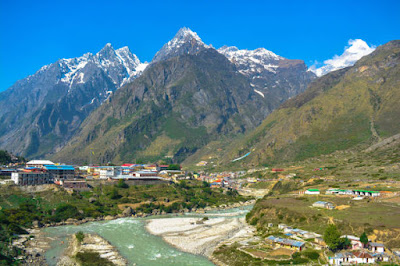(“Lord of Badri”) Badrinath is a Sacred place (tirtha) in the Himalayan region of Uttar Pradesh's Chamoli district, near the sources of the Alakananda River, the Ganges' biggest tributary.
Badrinath is located at a height of nearly 10,000 feet in the Himalayas.
- The Mana Pass, one of the ancient land routes via which Chinese products have entered India, connects it to Tibet.
- Due to its great altitude, Badrinath is only accessible from late April to October, after which it closes for the winter months; this pattern is repeated at the three main Himalayan pilgrimage sites of Yamunotri, Gangotri, and Kedarnath.
The name of the town originates from Vishnu, the reigning god whose temple is the cause for the town's existence.
- The temple's main image is said to have magically appeared full-formed from a shalagram, a kind of black stone containing fossilized ammonite and regarded a "self-manifested" form of Vishnu.
- Badrinath is a revered holy place with a lengthy history.
- Based on the architecture of some of the temple's oldest sections, scholars think it was inhabited by a Buddhist temple until several decades into the current century.
According to local legend, Buddhists from Tibet would come to the temple's closing rituals in the autumn until the Chinese shut the Tibetan border in the mid-twentieth century, carrying a hand-woven blanket to wrap over the picture.
- Badrinath is one of the four dhams (divine abodes) associated with the philosopher Shankaracharya in Hinduism.
- To fight the spread of Buddhism and revive Hindu religion, Shankaracharya is said to have chosen one Hindu holy place in each corner of the subcontinent.
- He created a Dashanami Sanyasi monastic center (math) at each center to educate knowledgeable monks.
- Badrinath is linked to the holy Jyotir Math, located forty miles south in the Himalayan town of Joshimath.
Each winter, the Badrinath picture is symbolically transferred to Joshimath's Narasimha shrine.
The Dandi Sanyasis were a group of ascetics devoted to the god Shiva who were also Nambudiri brahmins, the same caste into which Shankaracharya is said to have been born, according to Badrinath temple records.
- They were a group of ascetics devoted to the god Shiva who were also Nambudiri brahmins, the same caste into which Shankaracharya is supposed to have been born.
- When the last of these ascetics died without a successor in 1776, the shrine's guardian, a non-ascetic Nambudiri brahmin, was asked to serve as the temple's priest.
- This priest was granted the title rawal (“deputy”) in honor of his austere forefathers, and his extended family has administered the shrine ever since.
- Because the rawal is the only person permitted to touch the image, he must remain a bachelor, lest the ritual impurity (ashaucha) resulting from the birth of a child (sutakashaucha) make him incapable of performing his responsibilities.
The rawals used to have exclusive authority over the offerings made at the shrine, but since 1939, the temple has been run by a committee, and the rawal's role has been limited to ceremonial tasks.
You may also want to read more about Hinduism here.
Be sure to check out my writings on religion here.







